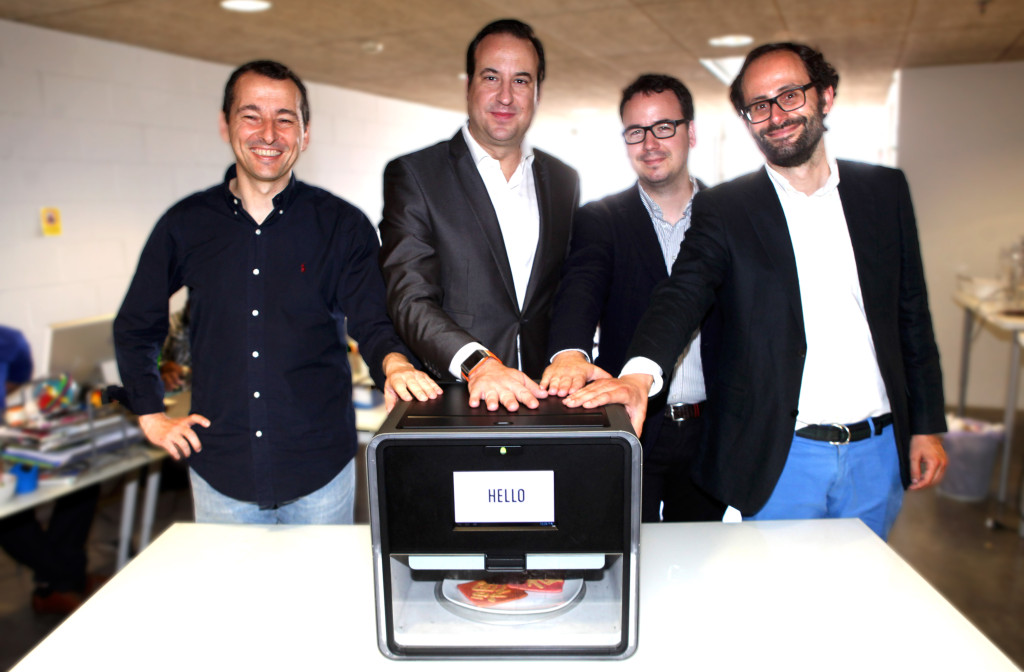Walt Disney once said, “Tomorrow can be a wonderful age” and sought to demonstrate his dream of a utopian future with Tomorrowland, the futurist-themed portion of his theme parks. It’s easy to picture, in his utopian vision, a device that 3D prints food catered specifically to a diner on demand. Naturally, the cutlery and flatware would all be 3D printed, too. And the meal would served by a polite and efficient robot. A food innovation company out of Barcelona, Reimagine Food, wants to make that vision a reality and they want to make it happen this year.

Reimagine Food, which wishes to transform “Barcelona into Silicon Valley”, is run by Marius Robles, who has spent the past ten years as an analyst for such big names as Siemens, Vodafone, Boeing, General Electric, Hewlett-Packard, Procter & Gamble, 3M and McDonalds. The company, though it does involve food printing, isn’t focused on the big picture of food innovation. Robles describes his company as:
…un ecosistema en el que integramos emprendedores vinculados con la alimentación y la gastronomía, empresas emergentes que han generado conceptos rompedores, y firmas de alimentación establecidas desde hace, al menos, 20 años. Hemos combinado todo eso en una batidora para crear conceptos únicos [an ecosystem that integrates entrepreneurs linked to food and gastronomy, emerging businesses that have generated groundbreaking concepts, and food companies that have been established for at least twenty years. We’ve thrown them all into a blender to make unique concepts].
And the company has already begun executing those unique concepts. This December 3, Reimagine Food, in partnership with GGlab, is throwing two exclusive dinners that execute the company’s vision of food innovation, one in Barcelona and one in New York. 12 guests, at each dinner, will be treated to an entirely 3D printed meal. Not only will the utensils and dishes be 3D printed, but the food itself will be 3D printed. The company has been researching what they call digital gastronomy with the help of 3D food printer manufacturer Natural Machines.
Reimagine has also added one more bit of sci-fi to the mix, the 3D printed lunches will be served by a robot called REEM, a robot meant to connect to a diner’s social networks, extract their mood and tastes, and choose the appropriate meal.
Added up, both meals will cost about 150,000 euros to create. The company’s chef, Paco Morales, says that the actual menu is still up in the air, explaining, “Tenemos varios platos pensados pero ahora estamso en plena fase de ensayo-error, trabajando duro para que la cena se convierta en un evento único e histórico [We have several dishes designed, but we’re still in the trial and error phase, working hard to ensure that the dinner is a unique and historic event].” Morales says of the technology itself, “Si hace 20 años el microondas era inimaginable, ¿por qué no vamos a tener también impresoras? Yo espero tener pronto esa persona dentro de mi equipo. Pero lo que hay que tener claro es que el cocinero o el guisante recién cogido es algo irremplazable [If 20 years ago the microwave was unimaginable, can’t we have food printers too? Soon I hope to have that member on my team. But what must be clear is that the chef or freshly picked pea is something that is irreplaceable].“

The company’s CEO hopes that they’re making strides towards a better future, saying: “Es una de mis obsesiones personales. Que la comida llegue a todo el mundo, que los restaurantes dejen de tirar el 30 % de lo que compran o que, como en 2050 no habrá carne para todos, consigamos desarrollar otros productos con los mismos nutrientes [It’s one of my personal obsessions, that food reaches all of the world, that restaurants stop throwing out 30% of what they buy, or that, in 2050, no one will eat meat, but we will develop other products with the same nutrients].”
I couldn’t agree with him more and I hope that, somehow, someday, 3D printed food served by humanoid robots brings us to that point. Or else, we’ll be left with Disney’s Tomorrowland as it stands today: a relic of soaring mid-century idealism brought to Earth the entropy of time.


